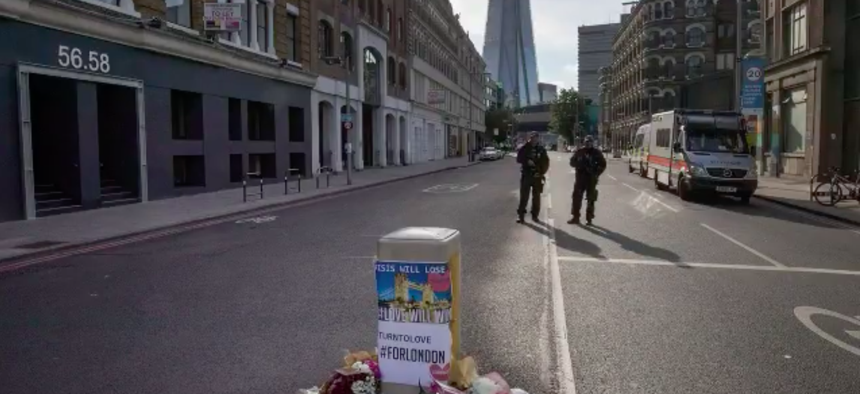The Trouble With How Liberals Talk About Terrorism
So what if falling objects kill more people? It's not just about the death toll.
Shortly after three men with knives and a van spent eight minutes murdering and maiming people at random on London Bridge, one of the Democratic Party’s leading voices on national security responded on Twitter. Chris Murphy began by criticizing Donald Trump for sounding the alarms. “My god,” he wrote. “@POTUS has no idea that the goal of terrorists is to instill a level of fear in the public disproportionate to the actual threat.” The Connecticut senator tried to put the threat in proper proportion. “Terrorism is a real threat,” he acknowledged, “but remember that since 9/11, you have a greater chance of being killed by a falling object than by terrorists.” Murphy then issued a five-point rebuttal to Trump’s approach to terrorism. He did not issue a five-point plan for defeating falling objects.
Maybe Murphy didn’t do this because falling objects are not equivalent to three men ramming and hacking people to death on London Bridge. Terrorists attack not just individuals but society, which makes mortality rates a poor measure of the danger terrorism poses. Falling objects “attack” neither. The men behind the carnage in London appear to have been inspired by ISIS, the same organization that has recently motivated young Muslim men to mow down civilians from Minya to Manchester, Berlin to Baghdad, Istanbul to Orlando, and beyond. Telling people not to be frightened by such acts—that fear is what the terrorists want—does not make those acts less frightening. Many people are scared byterrorism, despite the allegedly comforting statistics, because terrorism is scary. It’s designed to be. And most people recognize that while terrorism takes various forms, one of the most virulent strains these days is extremist violence committed in the name of Islam. They distinguish, in other words, between wobbly furniture and jihadist terror.
In the raw moments after a terrorist attack, people are often looking for recognition of the horror and reassurance that they’ll be kept safe, not to be told that they’re overreacting or to be soothed with unconvincing arguments. Franklin Roosevelt famously told Americans during the Great Depression that “the only thing we have to fear is fear itself—nameless, unreasoning, unjustified terror.” Less famous is how he contextualized that message. He listed the country’s many “dark realities”—the government deprived of revenue, families stripped of their savings, the unemployed facing the “grim problem of existence,” and so on. The good news, Roosevelt said, was that these were merely “material things,” and they could be regained. Before fear could be feared, it had to be reckoned with.
Murphy’s reaction to the London attack captures a common line of reasoning, particularly on the left, and it recalls some of the clinical rhetoric that Barack Obama used in similar circumstances. In repeatedly resisting (with someexceptions) any language that associated terrorism with extremist interpretations of Islam, the former president provided fodder to right-wing critics who argued that he was misleading people about the nature of the problem. And in his cerebral approach to counterterrorism, Obama could come across as tone-deaf to the public mood. After attackers killed 130 people in Paris , for example, Obama scoffed at reporters’ questions about whether the bloodshed would change his ISIS strategy. My colleague Jeffrey Goldberg documented what happened next on the president’s overseas trip:
Air Force One departed Antalya and arrived 10 hours later in Manila. That’s when the president’s advisers came to understand, in the words of one official, that “everyone back home had lost their minds.” Susan Rice, trying to comprehend the rising anxiety, searched her hotel television in vain for CNN, finding only the BBC and Fox News. She toggled between the two, looking for the mean, she told people on the trip.
Later, the president would say that he had failed to fully appreciate the fear many Americans were experiencing about the possibility of a Paris-style attack in the U.S. Great distance, a frantic schedule, and the jet-lag haze that envelops a globe-spanning presidential trip were working against him. But he has never believed that terrorism poses a threat to America commensurate with the fear it generates. Even during the period in 2014 when ISIS was executing its American captives in Syria, his emotions were in check. Valerie Jarrett, Obama’s closest adviser, told him people were worried that the group would soon take its beheading campaign to the U.S. “They’re not coming here to chop our heads off,” he reassured her. Obama frequently reminds his staff that terrorism takes far fewer lives in America than handguns, car accidents, and falls in bathtubs do. Several years ago, he expressed to me his admiration for Israelis’ “resilience” in the face of constant terrorism, and it is clear that he would like to see resilience replace panic in American society. Nevertheless, his advisers are fighting a constant rearguard action to keep Obama from placing terrorism in what he considers its “proper” perspective, out of concern that he will seem insensitive to the fears of the American people.
Into this emotional void stepped Donald Trump, who on terrorism is the id to Obama’s ego. He rails against political correctness, portrays “radical Islamic terrorism” as a grave threat to the nation, and embodies the fearful alarmism that terrorism can provoke.
Obama’s stance on terrorism also contained a contradiction. He argued that the terrorist threat was much less severe than other challenges such as climate change and gun violence. But he didn’t scale back his counterterrorism policies to reflect that assessment. After criticizing the excesses of George W. Bush’s war on terror, Obama launched a massive drone war against suspected terrorists in several countries. He urged the government to do more on gun violence, which is responsible for far more deaths per year in the United States than terrorism is, while simultaneously claiming that the U.S. government was right to “spend over a trillion dollars, and pass countless laws, and devote entire agencies to preventing terrorist attacks on our soil.” Either Obama never managed to invest in counterterrorism at the level he felt it deserved, or he was tacitly acknowledging that terrorism is, in fact, a big problem that statistics only partially capture.
Murphy faces a similar dilemma. He has developed a counterterrorism strategy that includes opposing Trump’s travel ban, which he claims will alienate and unfairly malign Muslims without reducing the terrorist threat; de-emphasizing military solutions to terrorism in favor of better-resourced diplomacy and a “new Marshall Plan” of economic assistance to the Middle East and Africa; and withholding U.S. support to Saudi Arabia unless it stops spreading fundamentalist Islam across the Muslim world.
“A progressive foreign policy isn’t just looking at the back-end of terrorism, but is also looking at the front-end of terrorism,” Murphy told me earlier this year. “And at the front-end of terrorism is bad U.S. military policy in the Middle East, is the Saudi funding of a very intolerant brand of Islam that becomes the building block of extremism, and poverty and political instability.”
Which is why it’s perplexing that, around the time we spoke, during a visit to Yale Law School, Murphy observed that Americans are more likely to be killed in an elevator accident or by lightning than by terrorism. Why ditch the Saudis and unveil a new Marshall Plan to solve a problem that’s less threatening than lightning?
NEXT STORY: The Right Way to Confront Iran in Syria





